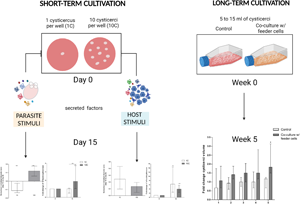Article contents
In vitro system for the growth and asexual multiplication of Taenia crassiceps cysticerci
Published online by Cambridge University Press: 27 September 2022
Abstract

Taenia solium is the aetiological agent of cysticercosis, a zoonosis that causes severe health and economic losses across Latin America, Africa and Asia. The most serious manifestation of the disease is neurocysticercosis, which occurs when the larval stage (cysticercus) establishes in the central nervous system. Using Taenia crassiceps as an experimental model organism for the study of cysticercosis, we aimed to identify the in vitro conditions necessary to allow parasite development at the short- and long terms. First, cysticerci were incubated for 15 days in different media and parasite densities. The number of buddings and cysticerci diameter were measured to evaluate asexual multiplication and parasite growth, respectively. Vitality was determined by trypan blue staining and morphology analysis. As a result, high cysticerci density and medium containing FBS and the excretion/secretion (E/S) products of feeder cells induced parasite survival, growth and multiplication. Then, the long-term (5 weeks) incubation of the parasites in co-culture with feeder cells was evaluated. Consequently, the mammalian cell lines induced a significant increase in total parasite volume while axenic cultures did not show any statistically significant change over time. In this study, the proper conditions to maintain T. crassiceps in vitro are described for the first time in a simpler and more controlled setting other than experimental infections. In addition, it was shown that cysticerci growth, survival and asexual multiplication depend on a complex network of secreted factors from both parasite and host.
- Type
- Research Article
- Information
- Copyright
- Copyright © The Author(s), 2022. Published by Cambridge University Press
References
- 1
- Cited by





